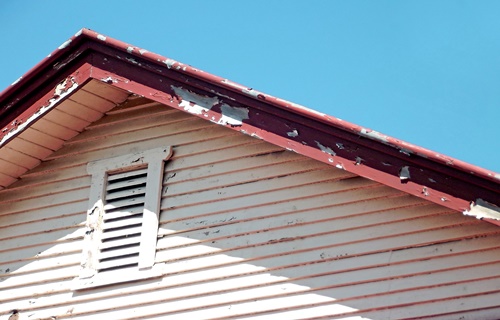Asbestos Lurking in Soffits and Fascias

Once a popular building material due to its insulating properties, durability, and fire resistance, asbestos can still be found in older buildings. Until the 1980s, the mineral was extensively utilized in home construction as it was a very effective and affordable fire-retardant material and thermal and acoustic insulator.
Among building elements made with asbestos are soffits on the undersides of an architectural structure, such as an arch, balcony, or eave. Asbestos soffits were manufactured by mixing asbestos fibers with a bonding material and pressed into a flat board. These boards were then installed underneath the eaves of roofs to create a finished look. Sometimes, soffits are decorative elements but serve many structural purposes. They are an essential but often overlooked construction feature, as they help protect homes from invaders while providing an esthetic transition from the roof to the exterior walls of a home.
In older homes, soffits were primarily decorative elements, and in other older structures, soffits hide things like structural beams, HVAC ducts, or plumbing. Soffit vents protected the attic space from mold and kept unwanted intruders like insects, pests, and birds out. Depending on their purposes, there are:
- interior soffits
- exterior soffits
Those on the exterior of homes are the most common types, mainly located on the roof's overhang at the edge of the eave, which is made up of two primary components:
- fascia - the outer vertical cladding that gutters attach to
- soffit - the horizontal cladding or framing that encloses the underside of the eave
Some older homes can have an eave without being enclosed by a soffit, but most houses constructed before the 1980s have asbestos soffits. You can easily find them by walking around your home while looking up at the roof. If you notice short planks and you can't see the rafters, you have found your soffits.
Like most asbestos-containing materials, asbestos soffits are indistinguishable from soffits that do not contain asbestos. They often resemble wood and are painted, so there's no particularity to look out for. Asbestos soffits were usually made from:
- cement board
- insulation board
Asbestos cement soffits are thinner and brittle, whereas insulation board soffits are thicker and more fibrous. Asbestos soffits often have a white/grey color and white spores or discoloration on the panels. However, there's only one way to know if the soffits on your home contain asbestos: to have the board tested in a laboratory. If the house was built before the 1980s and you spot some non-plastic soffit boarding, it is better to assume it could contain asbestos.
How Dangerous Are Asbestos Soffits and Fascias?
Due to their friability, soffits from asbestos insulation boards are considered high-risk asbestos-containing material. In contrast, asbestos cement soffits are qualified as a lower-risk asbestos-containing product with a lower tendency to break and release asbestos fibers. However, this doesn't mean the product isn't harmful and certainly doesn't mean it is safe to remove without protection.
If you intend to work on asbestos cement soffits, wear appropriate protection and follow exposure-preventing protocols. Only a licensed asbestos removal company should remove soffits from asbestos insulation boards. In this case, a DIY job is not advised. A licensed professional will have the equipment and training to safely remove the asbestos soffit without risking your health.
If removal is not an option, other measures, such as encapsulation, mitigate the risk of asbestos exposure. An asbestos abatement professional will apply a sealant or coating over the asbestos-containing materials to prevent the release of fibers. However, encapsulation is only a temporary solution, and it is crucial to monitor the condition of the soffits over time to ensure that they remain sealed. Asbestos soffit is a potentially hazardous building material, so having a licensed professional inspect it is crucial if you suspect your home may have such decor.
